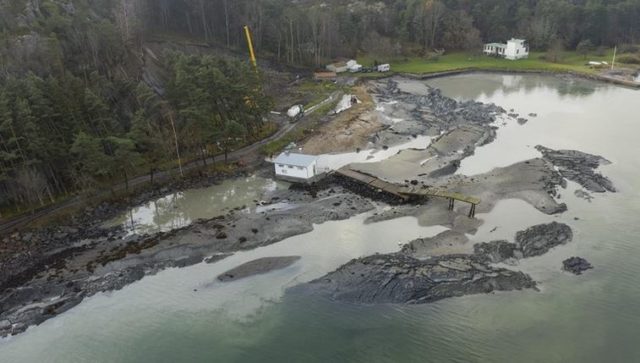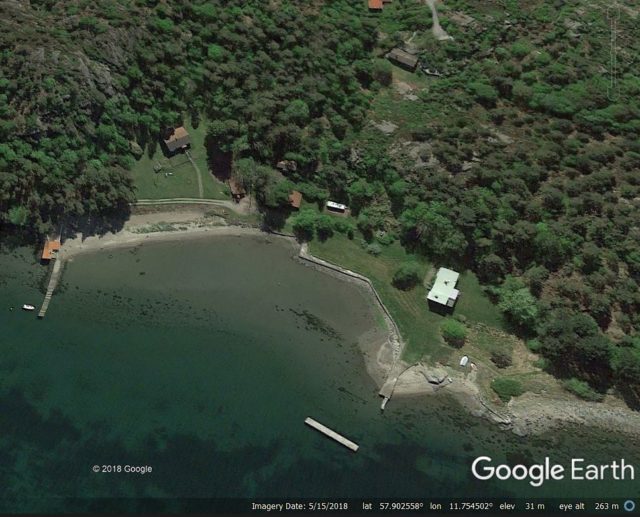14 November 2019
Lokeberg: an interesting quick clay slide triggered by piling in Western Sweden
Posted by Dave Petley
Lokeberg: an interesting quick clay slide triggered by piling in Western Sweden
In Lokeburg in western Sweden a significant landslide occurred yesterday (13 November 2019). Anton Larsson kindly highlighted this event to the community via Twitter, posting photographs of the aftermath.

The aftermath of the quick clay landslide at Lokeburg in Sweden. Image by Linus Olsson via Sverige Radio.
.
The large volume of displaced material under the now deformed and moved jetty is clear. In the trees on the left side of the image is a nicely formed rear scarp of the landslide. But note in the trees there is also clear evidence of a crane, and on the road there is a truck. News reports in Sweden link the landslide to the construction of a house at this location.
The location of the landslide is 57.903, 11.753, and there is good Google Earth imagery of the site:-

A Google Earth image of the site of the quick clay landslide at Lokeburg in Sweden.
.
Fortunately, no-one was killed or injured in the landslide. Anton Larsson tweeted to provide a possible explanation:
“Based on news reports, the workers were piling the area to ensure stability ahead of a rather luxurious beach house being built.”
However, subsequent reports have confirmed that it was not piling, but ground improvement through lime/cement-stabilization (which makes more sense in terms of the equipment present at the site). Thanks to Carolina for her helpful comment below that has clarified this point.
The most likely explanation for this landslide is that it is a quick clay slide. Quick clays are materials laid down in glaciomarine conditions that are “sensitive“, meaning that their strength can abruptly reduce when subjected to rapid changes in stress. The effect might be very local initially, but spreads through the deposit rapidly as the stress change propagates. This can lead to large-scale failures.
In this case a good working hypothesis would be that the piling operation generated the abrupt stress change that initiated the failure. Fortunately, the extent of the quick clay deposit was not particularly large, so the failure was contained.


 Dave Petley is the Vice-Chancellor of the University of Hull in the United Kingdom. His blog provides commentary and analysis of landslide events occurring worldwide, including the landslides themselves, latest research, and conferences and meetings.
Dave Petley is the Vice-Chancellor of the University of Hull in the United Kingdom. His blog provides commentary and analysis of landslide events occurring worldwide, including the landslides themselves, latest research, and conferences and meetings.
Thank you for a good summary. I just want to clarify that there was no piling performed, it was lime/cement-stabilization. It is more apparent in other pictures from the area. The news drew wrong assumptions of what the expert from the Swedish Geotechnical Institute said in the interview (“ground improvement”). This is now corrected in the new articles.
[Many thanks – this is now corrected in my post. D]
Having now looked at the site on Google Earth I am not surprised the piling rig is there and why they thought such a construction technique was suitable for the site. It appears at first glance that the adjacent hillslope consists of bedrock indicating that bedrock could be relatively close to surface where the crane is located. Certainly the use of a piling rig to either found pilings on rock, or to socket the piles into rock, would not negate the need to adequately characterize the overlying soils. Given the region, I am surprised the that a qualified geotechnical engineer, assuming one was involved with the project, would not have considered the piling-induced vibrations as a trigger for failure of the sensitive clays.
As a rule, I always consider how construction-induced vibrations could affect the stability of the earth/rock structures I design. One cannot be too careful when designing a project, especially when the means and methods of construction are not known at the time of design. I cannot advacate more for early contractor involvement in projects that have a high level of risk. I am just wrapping up design for an rockfill embankment dam with a secant pile wall for a water barrier and the project would have been cancelled long ago had a contractor not been engaged early in the process to help reduce the risks inherent to the project.